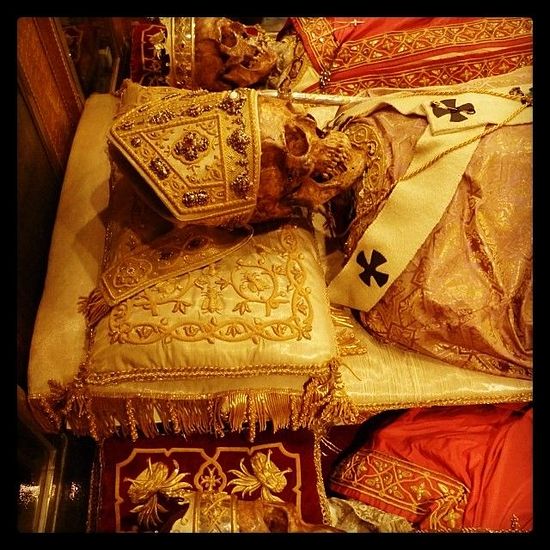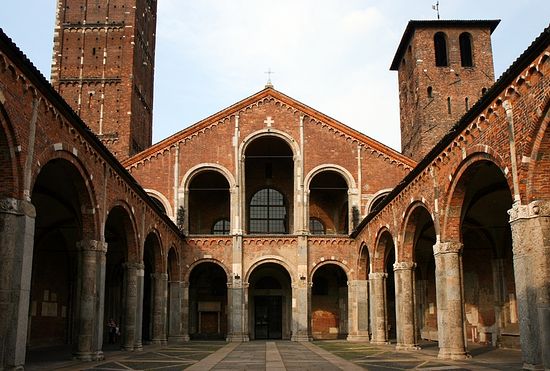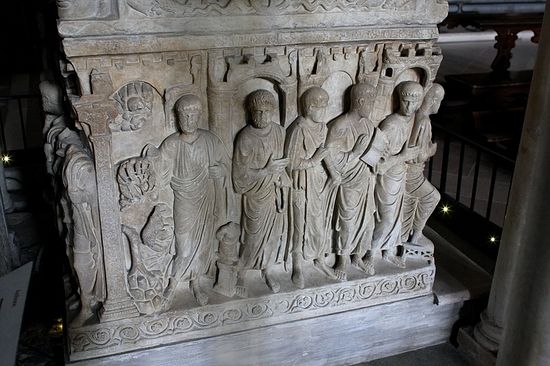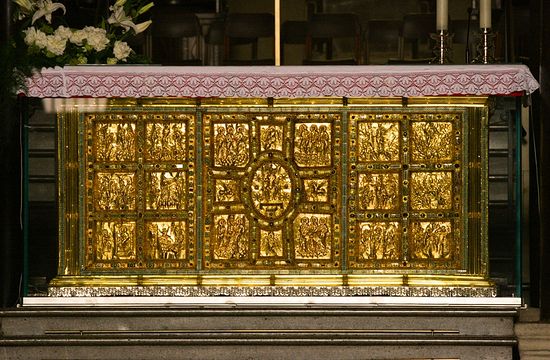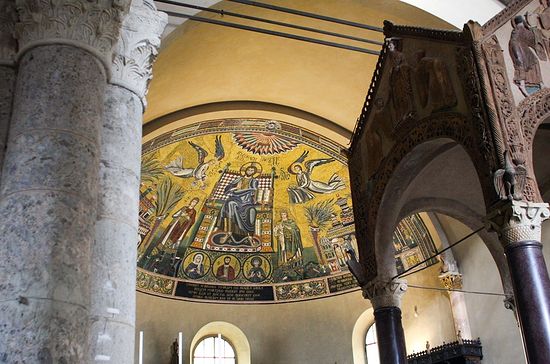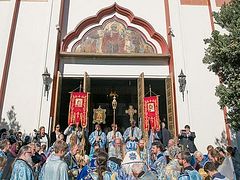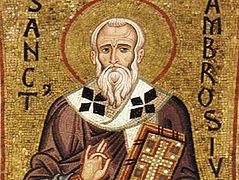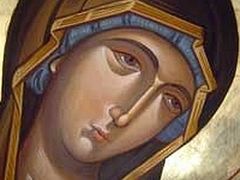History of Sant'Ambrogio (the Basilica of St. Ambrose)
Early Christian Basilica (4th century)
The Basilica of St. Ambrose was begun by Bishop Ambrose himself around 385 and consecrated in 386. The church was built on a grand scale over an existing cemetery, next to the martyrium of St. Victor. Two local martyrs provided the necessary relics for the altar, and Ambrose was buried next to them after his death on April 4, 397.
The original basilica has been excavated beneath the existing building. Surviving foundations indicate it had two side aisles, a marble floor, a semicircular apse, and a four-columned baldacchino over the high altar. The west facade has not been located so the exact length of the nave is unknown, but it had at least 13 bays.
It almost certainly had a large west porch on the same foundations as the present one. If so, it was a huge complex of more than 300 Roman feet long and 100 feet wide, larger than contemporary basilicas in Rome.
Romanesque Basilica (11th century)
The basilica was rebuilt in the Romanesque style in the 11th century and this is the building that survives today. Historical records are lacking when it comes to an exact date, but scholars believe it was probably begun around 1080 based on the history of architecture and engineering in Lombardy.
Historical records indicate that the old nave was still in use in 1067 and the new one was being used by 1093. However, it seems the westernmost bay of the nave was not completed until the south tower was begun in 1123. The vault was probably not built until after the earthquake of 1117. The basilica was completed around 1128.
What to See at Sant'Ambrogio
Exterioir
The Basilica di Sant'Ambrogio has an unusual exterior appearance, with an exceptionally large atrium stretching to the west and two towers of different heights. The atrium (dated by an inscription to 1098) is nearly as large as the church itself and makes an impressive sight after entering the small door at the west end. It now shelters archaeological fragments and tombs under its arcaded gallery, which is decorated with 6th-century capitals.
The visible part of the west facade has six open arches under a peaked roof. The south tower, known as the Monks' Tower, is quite simple in design and dates from the 10th century. Its northern counterpart is the more beautiful Canons' Tower, which was begun in 1123, interrupted in 1128 and finished according to the original designs after 1181. Similarities have been noted with the belfry of the Basilica di San Francesco in Assisi. Throughout much of its history the basilica was served both by monks and canons, who did not always get along. The communities each had their own cloister as well as their own tower.
Nave
From the atrium a narthex leads into nave, which has a high ribbed vault while the side aisles have groin vaulting. An octagonal lantern tower (built later) covers the transept crossing. There is a triforium but no clerestory (upper level with windows), so the nave would have been very dark before the lantern tower was added. It still is quite dark today.
The interior of the basilica is absolutely overflowing with medieval art, including: many Romanesque carved capitals, a 4th-century sarcophagus carved with biblical scenes (possibly suggested by Ambrose himself), a 9th-century silver altar, and a 10th-century canopy over the altar. Near the entrance on the right side of the nave is the "Serpent Column": a 10th-century Byzantine bronze serpent placed atop a short column.
Ambo (12th century)
On the north side of the nave stands a large marble ambo, which was made between 1130 and 1143 and reconstructed after the roof collapsed in 1196. The ambo is a type of pulpit and was used primarily for Gospel readings by the canons and monks. Supported by slender ancient columns, it was built on top of the 4th-centurySarcophagus of Stilichone (see below).
The fine Lombard Romanesque reliefs decorating the ambo are based on St. Ambrose's writings and center around the themes of sin and redemption. The north side shows a banquet, which represents either the Last Supper or the agape meal celebrated by early Christians every Sunday. The atlas figure on the southwest corner probably represents Daniel in the Lions' Den. Reliefs in the lunettes depict the Magi before Herod; the Adoration of the Magi; the Labor of Adam and Eve; and two birds drinking from a cup representing eternal life.
On the side facing the nave, there are two gilded copper sculptureswhich were probably attached to an earlier ambo. They date from the early 8th century and are considered magnificent examples of medieval metallurgy. They depict an eagle, representing St. John the Evangelist, and an angel, representing St. Matthew the Evangelist. The other two evangelists have been lost. The eagle may have functioned also as a book rest, just as many modern lecterns are in the shape of eagles.
Sarcophagus of Stilichone (4th century)
The Sarcophagus of Stililchone is a great treasure—not only is it a magnificent work of Early Christian art, it is one of the few surviving elements from Ambrose's original basilica. It still stands in the exact same place it has been since it was carved in 385 AD—the ambo was built around it. Moreover, it was carved during Ambrose's lifetime and its themes may have been suggested by the bishop himself.
The tomb was probably commissioned by and for a high military official, who appears with his wife on the north side of the sarcophagus and again in a roundel on the lid. Their identities remain unknown; the name of the sarcophagus dates from the 18th century and is based on an erroneous tradition that it was made for Stilichone, a general who died in 408 in the service of Emperor Honorius.
The sculptures on the sarcophagus are of exceptional quality, indicating they were carved by a Roman artist. The style of the work is called a "city gate sarcophagus" because of the prominent city walls and gates within the scenes. The south side (facing the nave) depicts the Traditio Legis, in which Christ hands the keys of Heaven to St. Peter. The other side shows Christ teaching the apostles, with the kneeling portraits of the patrons. The short sides have scenes from the Old Testament.
Golden Altar (9th century) and Ciborium (10th century)
The Golden Altar at the front of the nave was made in 835. It depicts the Life of Christ is in gold leaf on the front and the Life of St Ambrose in gilded silver on the back. The altar is sheltered by a canopy (known as a ciborium or baldacchino) made of four ancient columns and decorated with 10th-century stucco reliefs. The one facing the nave depicts Christ giving the Book of the Law to St. Paul (left) and the Keys of the Kingdom to St. Peter.
 Detail of 10th-century relief on the ciborium, showing Christ giving a book to Paul and keys to Peter. © Holly Hayes
Detail of 10th-century relief on the ciborium, showing Christ giving a book to Paul and keys to Peter. © Holly Hayes
Apse mosaic (9th—12th century)
The central scene of the apse mosaic has a late Byzantine layout and probably dates from the early 1200s. The side scenes are probably even earlier - dating from early 9th century in the Carolingian era. These connect St. Ambrose and the city of Milan (Mediolanum) with St. Martin and the city of Tours (Turonica). Both bishops were staunch opponents of the Arian heresy.
Crypt of St. Ambrose
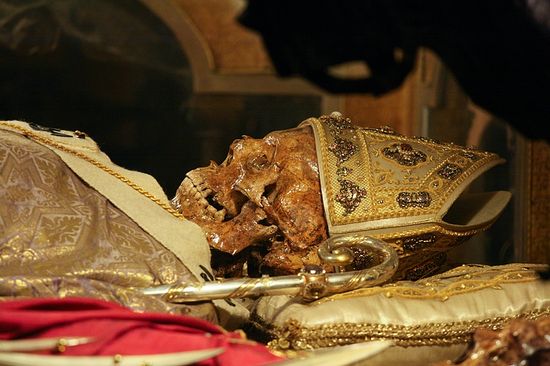 Skeleton of Bishop Ambrose (d. 397) on display in the crypt of Sant'Ambrogio Basilica, Milan. © Holly Hayes
Skeleton of Bishop Ambrose (d. 397) on display in the crypt of Sant'Ambrogio Basilica, Milan. © Holly Hayes
One of the most interesting sights in the Basilica of St. Ambrose is St. Ambrose himself! He is on display in the crypt, accompanied by St. Gervasius and Protasius. His skeleton is glazed with a protective coating and dressed in full bishop's finery, complete with white mitre and dainty slippers.
The accompanying saints are 3rd-century martyrs who were disinterred by Ambrose for the altar of his new basilica. They originally were buried in the nearby Chapel of Sts. Nabore and Felice (now destroyed).
The crypt was built in the late 10th century as part of major renovations in the east end of the basilica. The great silver urn enclosing the relics dates from 1897.
Sacello di San Vittore
At the end of the south aisle is the Sacello di San Vittore, a chapel whose origins predate the first basilica. Back when this site was still a cemetery, a small structure was built to honor St. Victor, a local martyr. St. Ambrose renovated the martyrium and built his basilica right next to it. It was renovated again around 500 AD.
When the basilica was rebuilt on a larger plan in the 11th century, the martyrium became part of the basilica. It is covered in mosaics of glittering gold from the 5th century, including a portrait of St. Ambrose. This portrait is significant because it was made not long after the saint's death (397), so it may reflect his actual appearance.

